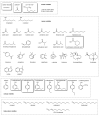Volatile Cues Influence Host-Choice in Arthropod Pests
- PMID: 33126768
- PMCID: PMC7692281
- DOI: 10.3390/ani10111984
Volatile Cues Influence Host-Choice in Arthropod Pests
Abstract
Many arthropod pests of humans and other animals select their preferred hosts by recognising volatile odour compounds contained in the hosts' 'volatilome'. Although there is prolific literature on chemical emissions from humans, published data on volatiles and vector attraction in other species are more sporadic. Despite several decades since the identification of a small number of critical volatiles underpinning specific host-vector relationships, synthetic chemicals or mixtures still largely fail to reproduce the attractiveness of natural hosts to their disease vectors. This review documents allelochemicals from non-human terrestrial animals and considers where challenges in collection and analysis have left shortfalls in animal volatilome research. A total of 1287 volatile organic compounds were identified from 141 species. Despite comparable diversity of entities in each compound class, no specific chemical is ubiquitous in all species reviewed, and over half are reported as unique to a single species. This review provides a rationale for future enquiries by highlighting research gaps, such as disregard for the contribution of breath volatiles to the whole animal volatilome and evaluating the role of allomones as vector deterrents. New opportunities to improve vector surveillance and disrupt disease transmission may be unveiled by understanding the host-associated stimuli that drive vector-host interactions.
Keywords: VOC; allelochemical; allomone; host–parasite interactions; kairomone; non-host volatile; vector; volatilome.
Conflict of interest statement
The author declares no conflict of interest.
Figures




Similar articles
-
Planning Implications Related to Sterilization-Sensitive Science Investigations Associated with Mars Sample Return (MSR).Astrobiology. 2022 Jun;22(S1):S112-S164. doi: 10.1089/AST.2021.0113. Epub 2022 May 19. Astrobiology. 2022. PMID: 34904892
-
Strong attraction of the parasitoid Cotesia marginiventris towards minor volatile compounds of maize.J Chem Ecol. 2009 Sep;35(9):999-1008. doi: 10.1007/s10886-009-9692-7. Epub 2009 Sep 25. J Chem Ecol. 2009. PMID: 19779759
-
Volatile Metabolites Emission by In Vivo Microalgae-An Overlooked Opportunity?Metabolites. 2017 Jul 31;7(3):39. doi: 10.3390/metabo7030039. Metabolites. 2017. PMID: 28788107 Free PMC article. Review.
-
Plasmodium falciparum gametocyte-induced volatiles enhance attraction of Anopheles mosquitoes in the field.Malar J. 2020 Sep 4;19(1):327. doi: 10.1186/s12936-020-03378-3. Malar J. 2020. PMID: 32887614 Free PMC article.
-
A literature survey of all volatiles from healthy human breath and bodily fluids: the human volatilome.J Breath Res. 2021 Apr 21;15(3). doi: 10.1088/1752-7163/abf1d0. J Breath Res. 2021. PMID: 33761469 Review.
Cited by
-
Developing attractants and repellents for ticks: promises and challenges.Curr Opin Insect Sci. 2024 Jun;63:101181. doi: 10.1016/j.cois.2024.101181. Epub 2024 Feb 23. Curr Opin Insect Sci. 2024. PMID: 38401667 Free PMC article. Review.
-
Synergistic attraction of Western black-legged ticks, Ixodes pacificus, to CO2 and odorant emissions from deer-associated microbes.R Soc Open Sci. 2023 May 17;10(5):230084. doi: 10.1098/rsos.230084. eCollection 2023 May. R Soc Open Sci. 2023. PMID: 37206969 Free PMC article.
-
Carbon Dioxide, Methane, and Synthetic Cattle Breath Volatiles Attract Host-Seeking Stable Flies, Stomoxys calcitrans.J Chem Ecol. 2024 Nov;50(11):643-653. doi: 10.1007/s10886-024-01502-0. Epub 2024 May 29. J Chem Ecol. 2024. PMID: 38806939
-
Microbially Mediated Chemical Ecology of Animals: A Review of Its Role in Conspecific Communication, Parasitism and Predation.Biology (Basel). 2021 Mar 27;10(4):274. doi: 10.3390/biology10040274. Biology (Basel). 2021. PMID: 33801728 Free PMC article. Review.
-
Perspectives on Odor-Based Control of Tsetse Flies in Africa.Front Physiol. 2022 Feb 18;13:831618. doi: 10.3389/fphys.2022.831618. eCollection 2022. Front Physiol. 2022. PMID: 35250633 Free PMC article. Review.
References
-
- Hansson B., Wicher D. Chapter 2—Chemical Ecology in Insects. In: Zufall F., Munger S.D., editors. Chemosensory Transduction. Academic Press; Cambridge, MA, USA: 2016. pp. 29–45.
-
- Brady J., Costantini C., Sagnon N., Gibson G., Coluzzi M. The role of body odours in the relative attractiveness of different men to malarial vectors in Burkina Faso. Ann. Trop. Med. Parasitol. 1997;91:S121–S122. doi: 10.1080/00034983.1997.11813252. - DOI
Publication types
LinkOut - more resources
Full Text Sources

